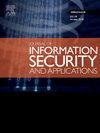SoK: Systematic analysis of adversarial threats against deep learning approaches for autonomous anomaly detection systems in SDN-IoT networks
IF 3.7
2区 计算机科学
Q2 COMPUTER SCIENCE, INFORMATION SYSTEMS
Journal of Information Security and Applications
Pub Date : 2025-09-19
DOI:10.1016/j.jisa.2025.104220
引用次数: 0
Abstract
Integrating Software Defined Networking (SDN) and the Internet of Things (IoT) enhances network control and flexibility. Deep Learning (DL)-based Autonomous Anomaly Detection (AAD) systems improve security by enabling real-time threat detection in SDN-IoT networks. However, these systems remain vulnerable to adversarial attacks that manipulate input data or exploit model weaknesses, significantly degrading detection accuracy. Existing research lacks a systematic analysis of adversarial vulnerabilities specific to DL-based AAD systems in SDN-IoT environments. This Systematisation of Knowledge (SoK) study introduces a structured adversarial threat model and a comprehensive taxonomy of attacks, categorising them into data-level, model-level, and hybrid threats. Unlike previous studies, we systematically evaluate white-box, black-box, and grey-box attack strategies across popular benchmark datasets (CICIDS2017, InSDN, and CICIoT2023). Our findings reveal that adversarial attacks can reduce detection accuracy by up to 48.4%, with Membership Inference causing the most significant drop. Carlini & Wagner and DeepFool achieve high evasion success rates. However, adversarial training enhances robustness, and its high computational overhead limits the real-time deployment of SDN-IoT applications. We propose adaptive countermeasures, including real-time adversarial mitigation, enhanced retraining mechanisms, and explainable AI-driven security frameworks. By integrating structured threat models, this study offers a more comprehensive approach to attack categorisation, impact assessment, and defence evaluation than previous research. Our work highlights critical vulnerabilities in existing DL-based AAD models and provides practical recommendations for improving resilience, interpretability, and computational efficiency. This study serves as a foundational reference for researchers and practitioners seeking to enhance DL-based AAD security in SDN-IoT networks, offering a systematic adversarial threat model and conceptual defence evaluation based on prior empirical studies.
SoK:针对SDN-IoT网络中自主异常检测系统的深度学习方法的对抗性威胁的系统分析
将软件定义网络(SDN)与物联网(IoT)相结合,增强了网络的控制力和灵活性。基于深度学习(DL)的自主异常检测(AAD)系统通过在SDN-IoT网络中实现实时威胁检测来提高安全性。然而,这些系统仍然容易受到操纵输入数据或利用模型弱点的对抗性攻击,这大大降低了检测的准确性。现有研究缺乏对SDN-IoT环境中基于dl的AAD系统特有的对抗性漏洞的系统分析。这项知识系统化(SoK)研究引入了结构化的对抗性威胁模型和全面的攻击分类,将它们分为数据级、模型级和混合威胁。与之前的研究不同,我们系统地评估了流行基准数据集(CICIDS2017、InSDN和CICIoT2023)上的白盒、黑盒和灰盒攻击策略。我们的研究结果表明,对抗性攻击可以使检测准确率降低48.4%,其中成员推理导致的下降最为显著。Carlini &; Wagner和DeepFool实现了很高的逃避成功率。然而,对抗训练增强了鲁棒性,其高计算开销限制了SDN-IoT应用的实时部署。我们提出了自适应对策,包括实时对抗缓解、增强再培训机制和可解释的人工智能驱动的安全框架。通过整合结构化威胁模型,本研究提供了一种比以往研究更全面的攻击分类、影响评估和防御评估方法。我们的工作突出了现有基于dl的AAD模型中的关键漏洞,并为提高弹性、可解释性和计算效率提供了实用建议。本研究在前人实证研究的基础上,提出了系统的对抗性威胁模型和概念防御评估,可为SDN-IoT网络中基于dl的AAD安全性提升的研究人员和实践者提供基础参考。
本文章由计算机程序翻译,如有差异,请以英文原文为准。
求助全文
约1分钟内获得全文
求助全文
来源期刊

Journal of Information Security and Applications
Computer Science-Computer Networks and Communications
CiteScore
10.90
自引率
5.40%
发文量
206
审稿时长
56 days
期刊介绍:
Journal of Information Security and Applications (JISA) focuses on the original research and practice-driven applications with relevance to information security and applications. JISA provides a common linkage between a vibrant scientific and research community and industry professionals by offering a clear view on modern problems and challenges in information security, as well as identifying promising scientific and "best-practice" solutions. JISA issues offer a balance between original research work and innovative industrial approaches by internationally renowned information security experts and researchers.
 求助内容:
求助内容: 应助结果提醒方式:
应助结果提醒方式:


